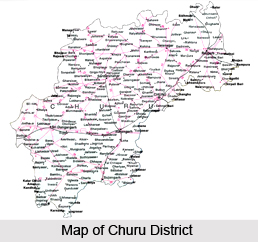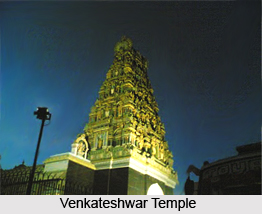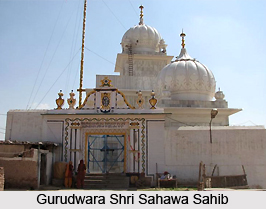 Churu district is situated in the North-East corner of Rajasthan. It is a place of great historical significance. The town is said to have been found by a Jat named Chuhru in 1620 AD. Churu, like an oasis, situated in the middle of the shifting golden sand dunes, opens the gate to the great Thar Desert in India. Churu District has a proud history from the time when its people fired silver cannon balls to defend its honour and freedom. Churu has freezing temperatures in winter and scorching heat in summer and its people have always struggled against famine and drought.
Churu district is situated in the North-East corner of Rajasthan. It is a place of great historical significance. The town is said to have been found by a Jat named Chuhru in 1620 AD. Churu, like an oasis, situated in the middle of the shifting golden sand dunes, opens the gate to the great Thar Desert in India. Churu District has a proud history from the time when its people fired silver cannon balls to defend its honour and freedom. Churu has freezing temperatures in winter and scorching heat in summer and its people have always struggled against famine and drought.
Location of Churu District
Churu district is located centrally in the north-eastern part of Rajasthan. It lies between 27 degrees 24 minutes to 29 degrees latitude and 73 degrees 40 minutes to 75 degrees 41 minutes longitude. Before independence, it was a part of Bikaner State. The district came into existence in 1948 comprising three tehsils- Churu, Rajgarh and Taranagar when the administration of Bikaner state was reorganized. The district, having a diversified climate and culture, occupied nearly 4.5 percent of the total area of the state. It is bound on the north by the Ganganagar district, on the east by Sikar and Jhunjhunu districts of Rajasthan and Hissar district of Haryana, on the south by Nagaur district and on the west by Bikaner district. Now it comprises of 5 sub-divisions, 6 tehsils, 2 sub-tehsils, 10 Municipalities and 908 villages.
 Administration of Churu District
Administration of Churu District
The District Collector and District Magistrate is the head of District administration. The Additional District Magistrate and the Chief Executive Officer, Zila Parishad are the two main helping hands at the district headquarters. As per the size and the need of the citizens, the district has been divided into five sub divisions. A Sub Divisional Officer (SDO) works at the sub division level to provide support and leadership to the administrative system at the local level. There are six tehsil headquarters in this district. Each one has a Tehsildar as the administrative officer, who works in accordance with the land-record system to serve rural farmers and land-holders. A tehsil contains a number of "Patwar-Mandals", each of which has a `Patwari` to serve the landholders and farmers at the village level. There is one Additional tehsil - Bidasar and two Sub tehsils - Bhanipura and Sidhmukh. Churu district is divided into 6 blocks (Panchayat Samitis) for the purpose of implementing and coordinating various developmental schemes. Each block has a Block Development Officer (BDO) to serve as extension and developmental executive at block level.
Economy of Churu District
Cultivation, which is dependent on monsoon, is the chief occupation of the people of the district. Irrigation is scarce. So the people migrate to other states and gulf countries for their livelihood. In such adverse conditions, the District Industries Centre has been trying to put the district among the industrially developed districts of the state. The major produce of the industries includes Wooden and Iron handicraft, Flour mill, P.V.C. wire, Cable, Condiments, Stone Door Frames, Mosaic Tiles, Cold Drinks and Mineral Water, Washing Soap, Namkeen and Bhujia industries, Plaster of Paris, Wooden Furniture, Gwar Gum, Papad, Namkeen, Oil Mill, Water Cooler Body, etc. Bidasar is a newly established industrial area.
Tourism in Churu District
 Churu gives the enchantment of its past glory and treasure to the visitors while one walks through the meandering streets, lined on either side by the largest havelis in the area. There are beautiful temples, chhatris (cenotaphs), the fort, the Johra (water tank) and wells which are all decorated with bright multicoloured wall paintings in various subjects. The city also has a museum named `Nagarshree`. The famous wealthy merchants of the town, having business connections all over India, added to its splendour by building beautiful majestic havelis, made of lime and brick and decorated them by the best of the frescoes on the facade as well as inside of the rooms. The best of the masons and `Chitera` or painters were employed to decorate these buildings. Blackbuck sanctuary, having more than 1680 black bucks and migratory birds, is the major attraction for wild life enthusiasts. The other attractions are grand palatial havalies in Ratannagar, Ratangarh and Sardarshahar towns, the Hanuman temple at Salasar, the Venkateshwar temple at Sujangarh, the birth place of local deity Goga Pir in Dadrewa and the Gurudwara in Sahawa.
Churu gives the enchantment of its past glory and treasure to the visitors while one walks through the meandering streets, lined on either side by the largest havelis in the area. There are beautiful temples, chhatris (cenotaphs), the fort, the Johra (water tank) and wells which are all decorated with bright multicoloured wall paintings in various subjects. The city also has a museum named `Nagarshree`. The famous wealthy merchants of the town, having business connections all over India, added to its splendour by building beautiful majestic havelis, made of lime and brick and decorated them by the best of the frescoes on the facade as well as inside of the rooms. The best of the masons and `Chitera` or painters were employed to decorate these buildings. Blackbuck sanctuary, having more than 1680 black bucks and migratory birds, is the major attraction for wild life enthusiasts. The other attractions are grand palatial havalies in Ratannagar, Ratangarh and Sardarshahar towns, the Hanuman temple at Salasar, the Venkateshwar temple at Sujangarh, the birth place of local deity Goga Pir in Dadrewa and the Gurudwara in Sahawa.



















